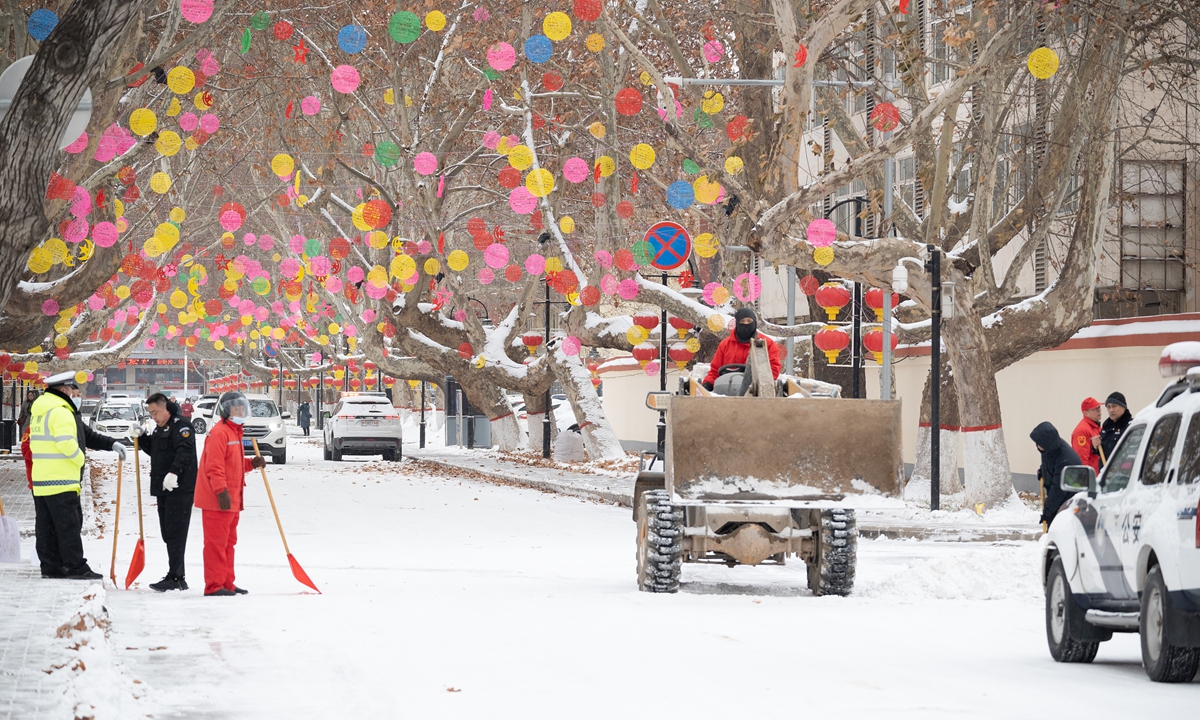Local govt ramps up effort to deal with heavy snow and rain as extreme weather disrupts Spring Festival travel rush

Photo: CFP
China's central meteorological authority maintained an orange warning for freezing weather and snowfall as extreme weather blankets central, eastern and southwestern parts of China. Local governments closed highways, deployed snow clearers to ensure road safety during the Spring Festival travel rush.
The National Meteorological Center (NMC) maintained an orange freezing warning on Friday, saying that from Friday to Sunday, persistent freezing rain will continue to hit areas of Henan, Anhui, and other provinces in central and southwestern China. It said that those places may witness accumulated freezing rain of 2-8 millimeters, with some areas exceeding 10 millimeters.
It is estimated that from Friday to Saturday, heavy to blizzard snowfall will cover parts of Henan, Anhui, Hubei and Hunan provinces. Areas such as in southwestern and northeastern Hubei will see heavy blizzard of 20-24 millimeters.
This is the first time that the NMC has issued an orange-level freezing warning, since the system was first established in 2010.
The rain and snow freezing weather impacting central and eastern China is reported to be strongest in about 15 years, and is likely to place extra strain on travel for millions over the next few days during the Spring Festival travel rush.
A total of 10 provinces will experience snowstorms or heavy snowfall, while seven provinces will experience freezing rain, media reported. The areas severely affected by rain and snow are mostly located in the central and eastern provinces, which are major transportation hubs in China.
The Central Committee of the Communist Party of China and the General Office of the State Council issued the Notice on the Prevention and Response of Low Temperature on Thursday, requiring all departments to make every effort to ensure the safety of people and property and the overall stability of society, and to ensure the public enjoy a happy and peaceful festival.
According to authorities, a total of 66 road sections have been closed in provinces and autonomous regions including Hebei, Shanxi, Inner Mongolia, Heilongjiang and Xinjiang. Additionally, 746 toll stations have been closed due to the snowfall and freezing road as of Thursday afternoon.
In order to restore traffic as soon as possible, Henan, which was among the hit hardest areas, deployed more than 8,000 traffic police officers and over 700 vehicles to deal with this snowfall, China Central Television reported.
From Wednesday to Thursday, more than 130 aircraft were used to clear ice at Zhengzhou Airport in Henan.
Changfeng county in Anhui province ordered strict supervision of key transportation vehicles, and inspect key facilities such as stations and bridges. It ordered the use of snow melting agents if icy conditions or vehicle skidding are detected on roads or bridges, speed limits and traffic controls will be implemented to prevent traffic accidents from occurring.
Shouguang city in Shandong, known as China's "vegetable capital," has shored up large quantity of anti-freezing materials such as cotton quilts, grass curtains, and plastic sheets, ready to be sent to places that are in need.
A passenger surnamed Zhou was one of the many trapped on a highway in Henan on Thursday. He told media that he was stuck in a traffic jam for over 10 kilometers on the highway, and it took him more than 40 minutes to exit a congested area. During the journey, he also witnessed several traffic accidents.
This rain and snow have been caused by excess water vapor brought by the eastward-moving and deepening southern trough, combined with the cold air. The formation of cyclone resulted in the strongest period of rain and snow from Saturday to Monday, said Xu Jun, an expert from the NMC.
It mainly affected the central and eastern regions of China, Xu noted.
The extreme weather is partly result of the moderate-intensity El Niño event, which began in May 2023, and peaked in December. It is currently entering a period of decline, while blizzards as well as freezing rain are expected to persist until early spring 2024, according to Zhao Junhu from the NMC.
